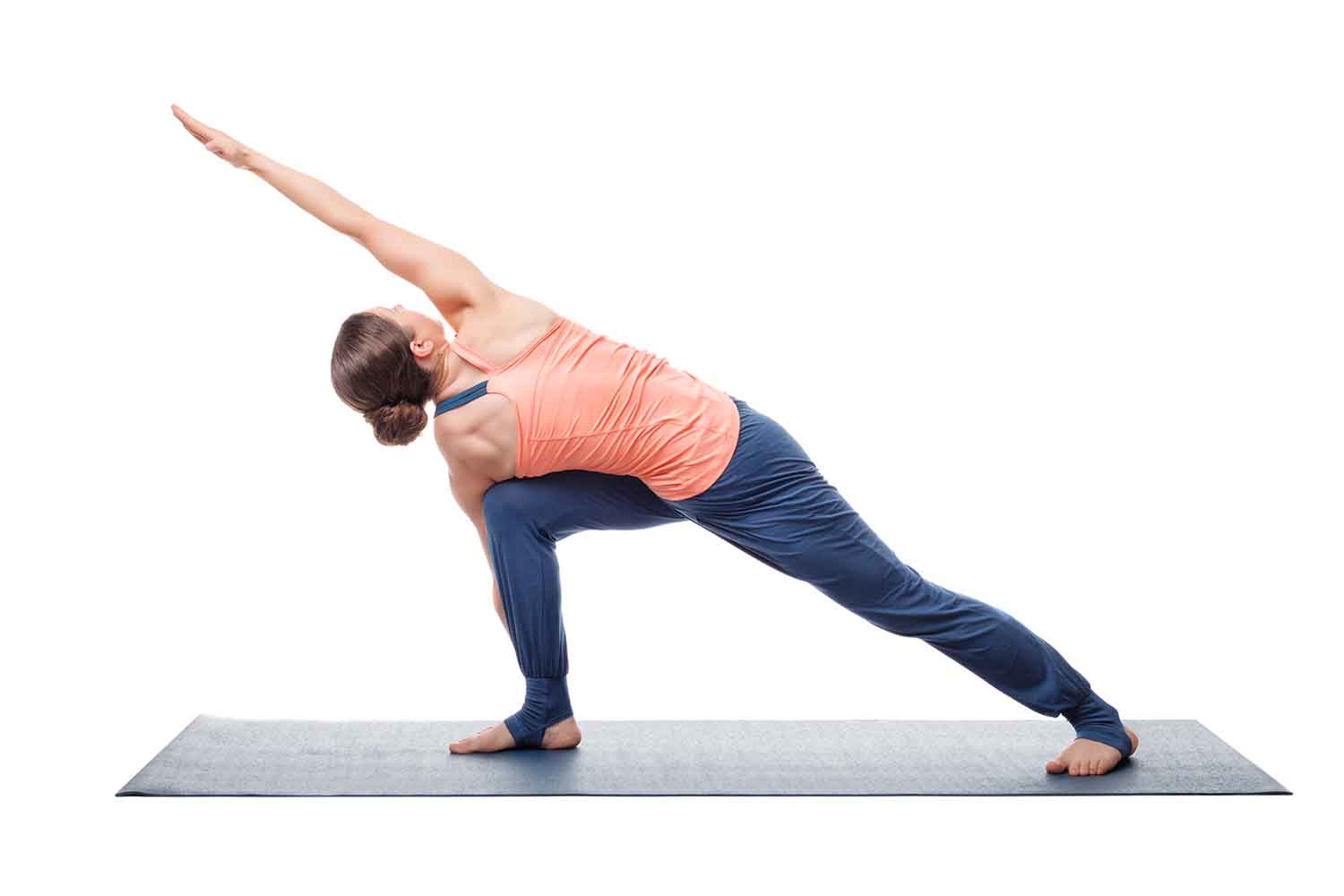Revolved Side Angle Pose in Yoga (Parivrtta Parsvakonasana) is a powerful standing twist that stretches and strengthens the legs, improves balance, and promotes spinal mobility. This pose enhances digestion and detoxification through the deep twist, while also opening the chest and shoulders. It challenges your balance and flexibility, making it an excellent pose for intermediate and advanced practitioners.
Other Names for Revolved Side Angle Pose
- Parivrtta Parsvakonasana
- Twisting Side Angle Pose
- Revolved Extended Side Angle Pose
How to Do Revolved Side Angle Pose in Yoga
To perform Revolved Side Angle Pose, follow these steps:
- Begin in a standing position, stepping your feet about 3 to 4 feet apart. Turn your right foot out 90 degrees and your left foot inward slightly.
- Bend your right knee to a 90-degree angle, making sure your knee is directly above your ankle.
- Inhale, lengthening your spine, and as you exhale, twist your torso toward your bent knee, bringing your left elbow to the outside of your right thigh.
- Press your palms together at your chest in a prayer position, keeping your elbows wide. Push your elbow against your thigh to deepen the twist.
- Extend your left leg actively, pressing the outer edge of your foot firmly into the ground to maintain stability.
- Hold for several breaths, lengthening your spine with each inhale and deepening the twist on the exhale.
- To exit the pose, slowly release the twist, straighten your legs, and return to a standing position. Repeat on the other side.
Variations of Revolved Side Angle Pose
Exploring variations of Revolved Side Angle can help deepen your practice and offer different benefits:
- Extended Revolved Side Angle: For a more intense stretch, extend your top arm over your head, creating a long line from your back foot to your fingertips.
- Bound Revolved Side Angle: Wrap your bottom arm under your thigh and reach your top arm behind your back to clasp hands. This version deepens the shoulder and chest stretch.
- Revolved Side Angle with a Block: If flexibility is limited, place your bottom hand on a block to maintain balance and proper alignment.
Modifications for Revolved Side Angle Pose
Modifications make this challenging pose more accessible:
- Use a Block: Rest your bottom hand on a block on the outside of your front foot to help maintain a long spine and stable alignment.
- Drop the Back Knee: If balancing is difficult, lower your back knee to the mat for additional support and focus on the twist.
- Shorten Your Stance: Bring your feet closer together to ease the intensity of the twist and maintain better balance.
Contraindications for Revolved Side Angle Pose
Revolved Side Angle Pose offers many benefits but requires caution in certain situations:
- Lower Back Issues: Twisting too deeply can strain the lower back, so individuals with lower back pain should modify the pose or avoid deep twists.
- Knee Injuries: Those with knee injuries should avoid over-bending the front knee and ensure proper alignment to prevent strain.
- Pregnancy: As the pose involves deep twisting through the abdomen, pregnant practitioners should avoid this pose or opt for an open twist without compressing the belly.
Tips to Improve Revolved Side Angle Pose in Your Practice
Improving your practice of Revolved Side Angle Pose involves focusing on alignment, breath, and balance. Here are key tips:
- Engage the Core: Activating your core muscles will help support the twist and protect your lower back.
- Square Your Hips: Keep your hips level and avoid letting the back hip rotate out of alignment.
- Lengthen the Spine: Focus on elongating your spine before deepening the twist. Length helps create space in the torso for a fuller twist.
- Ground Through the Back Foot: Press firmly into the outer edge of the back foot to stabilize the lower body and maintain balance.
- Breathe into the Twist: Use your breath to expand the ribcage on each inhale and twist deeper on the exhale.
What Muscles Does Revolved Side Angle Pose Work?
Revolved Side Angle Pose engages several key muscle groups, promoting strength, flexibility, and balance:
- Legs (Quadriceps and Hamstrings): The front leg is actively engaged while holding the bend, and the back leg stretches to maintain alignment and stability.
- Core (Obliques and Transverse Abdominis): Twisting engages the obliques and deep core muscles, helping to build core strength and stability.
- Spine (Erector Spinae): The muscles along the spine are engaged to maintain length and alignment during the twist.
- Shoulders and Chest: Twisting opens the chest and stretches the shoulder muscles, improving upper body flexibility.
- Hip Flexors (Psoas): The back leg’s hip flexors are stretched as the torso twists and the legs remain engaged.
Mental and Emotional Benefits of Revolved Side Angle Pose in Yoga
This dynamic pose offers a range of mental and emotional benefits:
- Improves Focus and Concentration: Balancing while twisting requires focus, helping to enhance mental clarity and concentration.
- Detoxifies the Body: The twist stimulates internal organs, aiding digestion and promoting detoxification.
- Reduces Stress: By releasing tension in the body, especially around the spine and shoulders, this pose promotes relaxation and mental calmness.
- Enhances Body Awareness: The pose requires a high level of body awareness, helping practitioners connect deeply with their physical and emotional state.
Is Revolved Side Angle Pose Suitable for Beginners?
While challenging, Revolved Side Angle Pose can be adapted for beginners with the following modifications:
- Use a Block: Rest your bottom hand on a block to bring the floor closer and maintain balance and proper alignment.
- Shorten Your Stance: Bringing the feet closer together reduces the intensity of the pose and improves stability for beginners.
- Practice the Twist First: Focus on practicing twists in seated or standing positions before incorporating balance elements.
Is Revolved Side Angle Pose Suitable for Advanced Practitioners?
Advanced practitioners can refine Revolved Side Angle Pose and explore deeper variations:
- Deepen the Twist: Advanced practitioners can work on bringing the chest closer to the front thigh and extending the top arm over the head for a deeper stretch.
- Explore Binds: Binding the arms behind the back challenges both flexibility and balance, adding complexity to the pose.
- Refine Alignment: Focus on squaring the hips, lengthening the spine, and finding precision in the twist to maximize the pose’s benefits.
How Does Revolved Side Angle Pose Contribute to a Yoga Sequence or Flow?
Revolved Side Angle is a versatile pose that adds dynamic movement and strength to a yoga sequence:
- Complements Twisting Sequences: Incorporating this pose into a twisting sequence enhances spinal flexibility and detoxification.
- Balances Strength and Stretching: It provides both strength and stretching for the legs, hips, and spine, making it a great transition between standing poses.
- Challenges Balance and Focus: As a balance-intensive pose, it encourages mindfulness and body awareness, key elements in any well-rounded yoga flow.
How Can I Deepen My Practice in Revolved Side Angle Pose?
To deepen your practice, consider these approaches:
- Focus on Length Before Twisting: Prioritize lengthening your spine to create space for a deeper and safer twist.
- Engage Your Core Fully: Use your core to stabilize and support the twist, helping you rotate deeper without compromising alignment.
- Experiment with Arm Position: Extending your top arm or working toward a bind will challenge both your flexibility and balance.
- Use Breath to Explore Depth: With each inhale, lengthen the spine, and on each exhale, twist deeper to maximize the pose’s potential.
Common Mistakes in Teaching Revolved Side Angle Pose
Avoid these common teaching errors for a safer and more effective practice:
- Misaligned Hips: Many students allow their back hip to open. Encourage practitioners to keep their hips level and square toward the front.
- Collapsing the Chest: Remind students to maintain length through the spine, avoiding a rounded back that compresses the chest.
- Forcing the Twist: Twisting too deeply before the spine is properly lengthened can cause strain. Emphasize the importance of elongating the spine before deepening the twist.
- Neglecting the Back Foot: Students often lose engagement in the back leg. Encourage them to press firmly into the back foot to stabilize the pose.
By addressing these common mistakes, teachers can guide students into a more mindful and effective practice in Revolved Side Angle Pose.
What are the benefits of revolved side angle pose?
The benefits of Revolved Side Angle Pose include improving spinal flexibility, strengthening the legs and core, and enhancing balance and focus. This twisting posture stimulates the abdominal organs, aids in digestion, and aligns the spine. It is commonly practiced in Vinyasa yoga and incorporates principles from Hatha and Ashtanga traditions.
Which yoga pose is best for acid reflux?
The best yoga pose for acid reflux is the Revolved Side Angle Pose, which helps improve digestion and reduce stomach acid by stimulating abdominal organs. Gentle poses like Supta Baddha Konasana and Legs-Up-the-Wall Pose also support relaxation and minimize reflux symptoms when practiced regularly.

